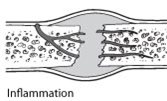Noida: Arthritis is commonly associated with joint pain, stiffness and swelling, is no longer a disease confined to the elderly. Health experts now warn that an increasing number of young people are falling prey to this chronic condition, driven by unhealthy lifestyles, poor dietary habits, physical inactivity and rising obesity levels.
However, recent research has added another alarming factor air pollution. Experts highlight that pollution is not just affecting lungs but is also playing a significant role in triggering autoimmune disorders like rheumatoid arthritis, where the body’s immune system mistakenly attacks joint tissues, leading to inflammation, pain and stiffness.
Pollution and rising rheumatoid arthritis cases
At the 40th Annual Conference of the Indian Rheumatology Association (IRACON 2025), held to mark World Arthritis Day (October 12), medical experts discussed how worsening air quality, especially high PM2.5 levels in Delhi-NCR, is directly linked to a spike in rheumatoid arthritis cases.
Long-term exposure to polluted air alters immune function, increasing inflammation in the body. This may explain why we are now seeing arthritis even among young office-goers and college students.
Experts
Warning signs you shouldn’t ignore
Persistent joint pain, stiffness (especially in the morning) or swelling are early warning signs of arthritis. Ignoring these symptoms can lead to chronic pain, limited mobility, and a decline in overall quality of life. Doctors emphasize timely diagnosis, as early treatment can prevent long-term damage.
A growing health crisis
Public health agencies in India are increasingly recognizing arthritis as an emerging health concern. With changing lifestyle patterns and environmental degradation, the disease is becoming more common in the working-age population. Experts recommend a multi-pronged approach to prevention, promoting regular exercise, maintaining a balanced diet, reducing stress and ensuring clean air and surroundings. Equally important is public awareness about the disease and its preventable causes.

